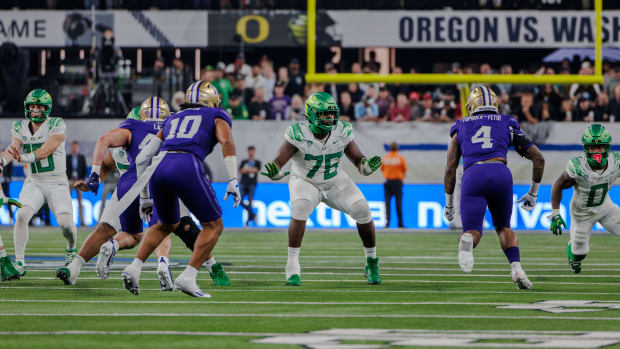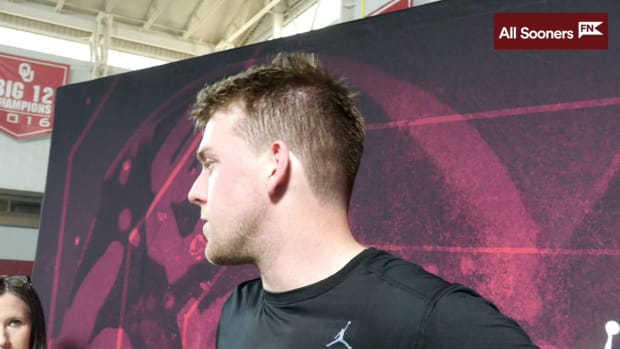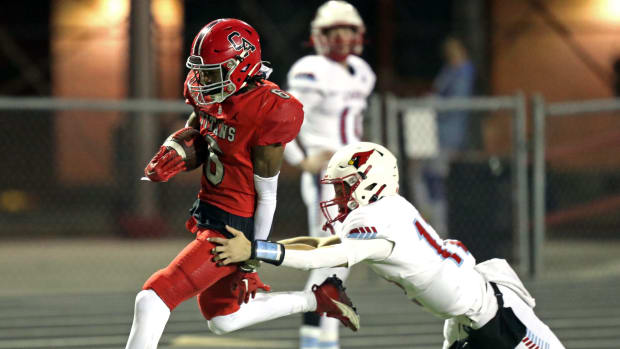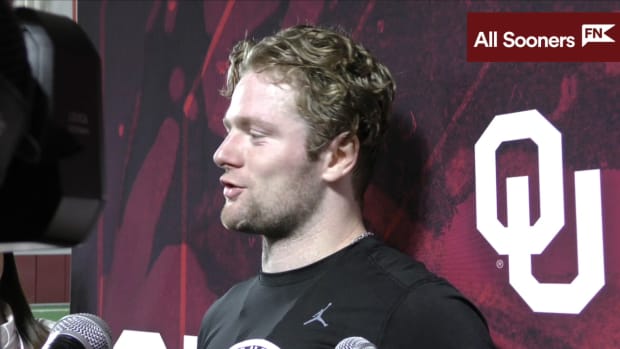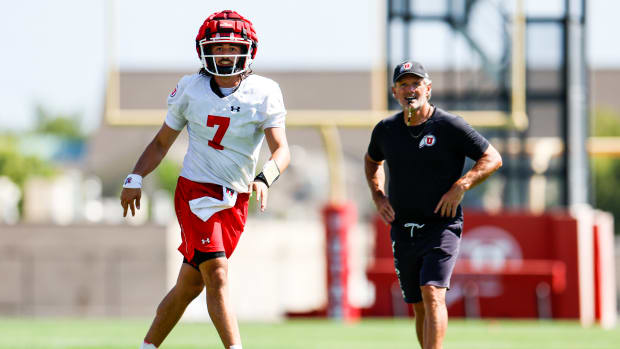
The new reality: Behind the scenes of ESPN's first playoff rankings show
BRISTOL, Conn. -- It’s a little after 4:30 p.m. on Oct. 28 and ESPN’s Rece Davis, Danny Kanell and David Pollack just want to know what everyone else wants to know: Who is going to be in the top four of the College Football Playoff selection committee’s initial rankings?
The crew for College Football Live is expecting to receive the rankings around 5 p.m., and at a production meeting earlier in the day, the decision was made to keep Davis, Kanell and Pollack in the dark so that the three can react in real time.
Pollack and Kanell discuss the factors that will go into the committee’s rankings, including strength of schedule and head-to-head play, and are trying to decide what matters most.
“I got like a nervous pit in my stomach when I saw the room and the people [in the committee],” Pollack told SI.com. “It’s the first time you’ve ever done it. It’s that new feeling, that Christmas morning feeling, so there’s definitely a lot of excitement. It’s never been done before. There are growing pains sometimes, and I think we’ll find out a little bit about the committee. What do you place as the important things? What’s the premium? There’s a lot of rules that are outlined, but we don’t know which certain ones they’re going to place more emphasis on.”
This is the new reality in college football, where discussions like Pollack and Kanell’s are happening all over the country consistently. And this is the new reality at ESPN, which is investing more than $5.6 billion in the playoff over the next 12 years.
• INSIDE READ: Why you'll be angry with the playoff by December
ESPN sees the first rankings show on Tuesday as the culmination of nearly a year’s worth of work, starting with the unveiling of an ad that was striking in its simplicity -- an empty bracket -- during the national championship between Auburn and Florida State.
The network, operating out of a Bond villain lair-like maze of buildings and satellite dishes plopped down in a town that could easily be mistaken for the fictional town of Stars Hollow from Gilmore Girls, obviously wants to protect its investment and make all that work matter.
“It would be easy for any media company to talk about how much they value this property,” ESPN vice president of programming and acquisitions Ilan Ben-Hanan said. “From ESPN’s perspective it was more a demonstration of how much we value college football. When it came time to negotiate, we spent very little time on just the seven games. We spent a lot of time talking about our season-long commitment, our year-long commitment, what we do in the studio, what we do in game coverage, how we treat the sport and the major stake we have in its success.”
The rankings show is a big tentpole in that season-long commitment. After the committee decided to do weekly rankings, it would’ve been easy to release them on Sundays with little fanfare, the same way the AP and Coaches polls are released. Instead, by claiming prime-time real estate on Tuesdays previously only occupied by the NBA, and revealing the rankings on ESPN, the committee is opening itself up to even more scrutiny.
Not that anyone at ESPN seems to have a problem with that.
“We like the controversy,” College Football Liveproducer Nick Sciallo said. “Controversy breeds interest. Controversy breeds discussion, and that’s what we’re able to provide for fans. It’s great for us, but I think for sure it’s great for the fans.”
*****
With the rankings coming in just a few hours, ESPN is once again battling accusations of that ugly four-letter word that every sportswriter is familiar with: bias.
It’s still not wholly evident what prompted Chris Fowler to rail against the suggestion of SEC bias on College GameDay in Week 9. He fired back, saying “I'm a little defensive, but I get defensive when stupid, uninformed stuff gets repeated again and again, and people all over the world think that somehow we have a stake in having three teams from this league get in.”
The issue of bias came up in multiple articles leading up to the first rankings reveal, with ESPN being charged with building up the SEC (and tearing down other conferences) to sway poll voters as well as having a say in who got put where when the committee finally got to ranking (naturally, to inflate the ESPN-owned SEC Network’s worth).
• STAPLES: Is the SEC West as good as we thought?; Punt, Pass & Pork
“When we cover the sport, we have an obligation and a charge to be fair,” Davis said. “It doesn’t mean we don’t have a perspective or a frame of reference or something that we think is important. Every human being has that. We try to look at it through a prism of fairness. The fan’s only obligation -- and it should be their only obligation -- is to look at it through the prism of how does it affect my team? There’s going to be an inherent inequity in those two points of view, and you’re not going to be able to come to a resolution that solves everything because people are always going to look at it from the perspective of their own team.”
Dressed in workout gear, a blue Under Armor thermal, shorts, long black socks and Nike shoes, Kanell shows Pollack an article on his phone that just came out on Rolling Stone's website earlier Tuesday.
“Look at this,” Kanell says. “It’s about how we hate Florida State, written by a Florida State grad, and it doesn’t mention that anywhere in here. But we’re biased.”
Kanell has come under fire for his comments and rankings pretty much all season long, though for different reasons than the rest of the supposedly SEC-biased ESPN analysts. Between having no SEC West teams in his top one-loss teams recently to having Notre Dame ranked fourth in his final top four before the official rankings were released, Kanell gets scorned fairly regularly. His Twitter mentions are a minefield of people calling him an “idiot” (and much worse), but he does his best to laugh it off, at least publicly.
If anything, the release of the committee’s first rankings has the former Florida State quarterback breathing a sigh of relief.
“I’m thrilled that the Twitter trolls can now go after the committee and not us,” Kanell said. “I see the disagreements that are between the analysts around here, guys that watch college football every single Saturday and every day of the week. We have disagreements. I want to see what compromises [the committee] make with their top four and top 25.”
*****
The College Football Live crew faces the somewhat unique task of having to prepare for a show for which the main content is still fluid and changing. After receiving the rankings, the graphics team has about two hours to prep; get tiles of each of the one-loss teams’ résumés; make sure Jeff Long, the chairman of the College Football Playoff selection committee, is mic’d up and ready to go in Dallas; and tie up all of the necessary loose ends.
With just over 10 minutes until the show goes live, the control room is buzzing. There’s one quick run-through of the show’s intro and a double-checking of spellings, graphics, and of course the rankings themselves.
Amazingly the list didn’t leak, as was a concern throughout the day and will continue to be a concern each week.
Just a few minutes later, the countdown begins.
“90 seconds: Have a good show, everyone.”
“30 seconds: Let’s make college football history.”
“15 seconds: Have fun, guys.”
“5-4-3-2-1: Rolling.”
The first 10 minutes are orchestrated from the control room, with graphics put on the screen, graphics being wiped, other graphics put in the queue, microphones on, microphones off and cameras rolling.
The rankings are finally released, and there’s the top four: Mississippi State, Florida State, Auburn and Ole Miss. There really were three SEC teams in the top four, and ESPN got the visceral reaction it was looking for from its analysts.
“Ohhhhhh wowwwwwww,” Pollack says.
“No way,” says Kirk Herbstreit, patched into the broadcast from his home.
• ROUNDTABLE: What did we learn from playoff committee's first rankings?
The first segment runs smoothly, and the show goes to a break. There’s some clapping and a few fist pumps in the monitor-filled room.
“That played out exactly how we wanted it to,” said Lee Fitting, ESPN senior coordinating producer for college sports studio shows.
Down in the studio Pollack, Kanell and Davis are still debating the rankings off camera between sips through straws stuffed into the lids of extra large Starbucks cups. “What do you do with TCU? It has No. 20 and No. 9 back to back.” “We’ve got an elimination game already between Ole Miss and Auburn, so that’s basically a play-in.” “There’s no right answer.”
“This is awesome,” Pollack says. “I love this.”
There are still six more weeks of this to go, and the committee is going to be under a microscope each and every Tuesday. Whereas the NCAA men’s and women’s basketball tournament committees meet in secret and release just the one final bracket, the College Football Playoff committee will have to deal with countless comments from fans throughout the second half of the season.
The committee has said it won’t be swayed by public opinion, but it’s putting its reputation out there front and center for the world to see in prime time each week.
Like everyone else, the ESPN crew is waiting to see how this thing plays out.
“They probably created some trouble for themselves,” Davis said. “But I think that this is what people want. It’s what the appetite was for. But with that if you’re going to say, ‘I don’t want the computers. I don’t want the ultimate blind objectivity,’ then you’re going to have to live with a little subjectivity from those 12 people in the room. I think that’s a good thing because I consider it more art than science anyway.”
